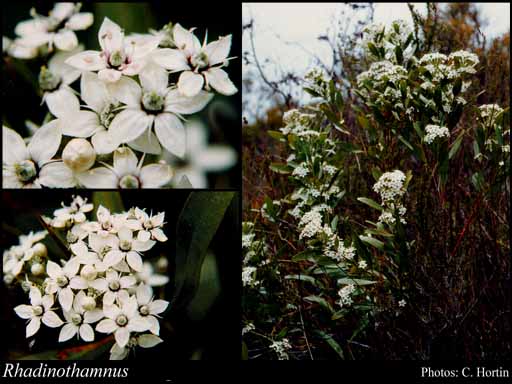This name is not current. Find out more information on related names.
- Reference
- Nuytsia 1(2):197 (1971)
- Name Status
- Not Current

Scientific Description
Family Rutaceae.
Habit and leaf form. Silvery shrubs; evergreen, or deciduous; bearing essential oils. Mesophytic, or xerophytic. Leaves alternate; leathery, or ‘herbaceous’; petiolate; non-sheathing; gland-dotted; aromatic; simple, or compound; when compound ternate, or pinnate, or bipinnate, or unifoliolate. Leaf blades when simple dissected, or entire; when simple/dissected pinnatifid, or much-divided; pinnately veined, or one-veined. Leaves without stipules, or with stipules. Stipules when present, intrapetiolar; represented by glands. Leaves without a persistent basal meristem. Leaf anatomy. Hairs absent (lepidote trichomes present). Stem anatomy. Nodes unilacunar, or tri-lacunar. Secondary thickening developing from a conventional cambial ring.
Reproductive type, pollination. Fertile flowers hermaphrodite. Unisexual flowers absent. Plants hermaphrodite. Entomophilous.
Inflorescence and flower features. Flowers solitary, or aggregated in ‘inflorescences’; axillary; in cymes. The terminal inflorescence unit cymose, or racemose. Inflorescences terminal, or axillary, or epiphyllous. Flowers bracteate; pedicel bi- bracteolate (in lower half); small to medium-sized; fragrant; regular, or somewhat irregular. The floral asymmetry when noticeable, involving the perianth and involving the androecium (not K). Flowers (3–)5 merous; cyclic. Floral receptacle developing a gynophore (associated with the disk), or with neither androphore nor gynophore. Free hypanthium absent. Hypogynous disk present (short); intrastaminal; annular (sometimes one-sided), or of separate members. Perianth with distinct calyx and corolla; (3–)6, or (6–)10; 2 -whorled; isomerous. Calyx present; (3–)4, or 5; 1 -whorled; gamosepalous; undulately lobed; imbricate; patelliform or hemispherical; regular; with the median member posterior. Corolla (3–)4, or 5; 1 -whorled; polypetalous, or gamopetalous; valvate; regular, or unequal but not bilabiate; white. Androecium 2, or 3, or 5, or 8, or 10, or 20–60. Androecial members unbranched, or branched (? by the splitting of simple primordia); free of the perianth; all equal, or markedly unequal; free of one another, or coherent (? the filaments usually more or less basally connate); 1 - adelphous, or 3–12 - adelphous; 1 -whorled, or 2 -whorled. Androecium exclusively of fertile stamens, or including staminodes. Staminodes (often representing the antepetalous whorl) (3–)4, or 5(–10). Stamens 2–60; reduced in number relative to the adjacent perianth to polystemonous; alternisepalous, or oppositisepalous (? when the outer whorl lost). Anthers dorsifixed, or basifixed (? more or less); versatile; dehiscing via longitudinal slits; introrse, or latrorse; tetrasporangiate; appendaged; apiculate (apiculum non-glandular). Gynoecium (1–)3 carpelled, or 4–5(–100) carpelled. The pistil when syncarpous, (1–)4–5(–100) celled. Gynoecium apocarpous, or syncarpous; eu-apocarpous, or semicarpous, or synstylous; superior. Carpel with or without a sterile apex; (when apo- or semicarpous) (1–)2–100 ovuled. Placentation of the free carpels marginal. Ovary unilocular, or plurilocular; when syncarpous, (1–)4–5(–100) locular. Styles 1, or 3–5; free, or partially joined; apical. Stigmas wet type, or dry type; papillate, or non-papillate; Group II type, or Group IV type. Placentation when syncarpous, axile. Ovules 1–5(–50) per locule; pendulous to ascending; epitropous; when two or more per cell, collateral, or superposed, or biseriate; arillate, or non-arillate; anatropous, or hemianatropous.
Fruit and seed features. Fruit fleshy, or non-fleshy; an aggregate, or not an aggregate. The fruiting carpel dehiscent, or indehiscent; baccate (cocci erect). Fruit (when syncarpous) dehiscent, or indehiscent, or a schizocarp. Mericarps when schizocarpic, comprising berrylets, or comprising follicles, or comprising nutlets, or comprising drupelets. Fruit when syncarpous and non-schizocarpic, a berry, or a drupe. Seeds narrow-reniform or bluntly ellipsoidal; endospermic, or non-endospermic. Embryo well differentiated. Cotyledons 2. Embryo chlorophyllous, or achlorophyllous; straight, or curved, or bent. Seedling. Germination phanerocotylar, or cryptocotylar.
Physiology, biochemistry. Aluminium accumulation not found. Photosynthetic pathway: C3.
Geography, cytology, number of species. A genus of 4 species.
Additional characters Petals shortly uninerved, or multinerved.
Taxonomic Literature
- Wheeler, Judy; Marchant, Neville; Lewington, Margaret; Graham, Lorraine 2002. Flora of the south west, Bunbury, Augusta, Denmark. Volume 2, dicotyledons. Australian Biological Resources Study.. Canberra..
- Grieve, B. J.; Blackall, W. E. 1998. How to know Western Australian wildflowers : a key to the flora of the extratropical regions of Western Australia. Part II, Dicotyledons (Amaranthaceae to Lythraceae). University of W.A. Press.. Nedlands, W.A..
- Wilson, Paul G. 1998. New species and nomenclatural changes in Phebalium and related genera (Rutaceae).